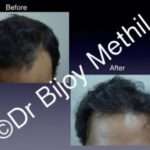Hair Transplantation Surgery For Baldness
The only permanent remedy for hair loss is surgical hair restoration, or hair transplantation . It is the only method which can replace natural growing hair & correct thinning or bald areas.
95% of all cases in men are due to a condition called ” androgenetic alopecia .” This is commonly referred to as ” male pattern baldness .”
Most cases of hair loss in women are due to inherited female pattern balding , but medical conditions such as low thyroid levels, hormonal imbalances (elevated testosterone), binge dieting, and pregnancy can contribute to the condition. Women tend to experience a subtle thinning all over the scalp and loss of volume at the top.
You may loose 10 to 200 strands of hair per day. But this hair is not dead as all the hair that falls gets replaced with new growing hair. The hair goes through a generation, growth and fall cycle which continues again with generation of new hair. You do not become bald because you are loosing more hair, you will become bald when the lost hair is not replaced with new hair.
Who Needs A Hair Transplant?
Anybody below age of 23 years or not having hair loss beyond Grade III is not considered for hair transplant surgery. Patients with grade 3 hair loss respond with medicines alone; unless the patient desires to change the hairline or bring forward the temporal receding on either sides. Patients with grade 4 hair loss and more require medicines and surgery to achieve a desirable result.
Procedure
Follicular Unit Transplantation (FUT)
Even today, the gold standard procedure for Hair restoration is Follicular Unit Grafting . A follicular unit is the naturally occurring grouping of hairs containing from 1 – 3, occasionally 4 hairs. As many as 2500 grafts can be transplanted in a single procedure lasting 6 – 10 hours.
Hair transplantation surgery involves removing a small strip of hair-bearing scalp from the back or sides of your head. The area from which the strip is taken is carefully closed, resulting in a very fine line scar which is completely hidden amongst the remaining hair.
Our surgical team then microscopically divides the harvested strip of hair-bearing scalp into micro (follicular) grafts and macro (follicular) grafts. The grafts can be inserted into tiny needle- sized sites in the recipient area. A combination of these different sized grafts is used in the hair restoration, with the one-hair grafts in an irregular pattern along the hairline, and two, three and four-hair grafts placed further behind to create more density. By transplanting follicular units , the way hair grows naturally, the results of the hair transplantation are virtually undetectable. The grafted hair eventually grow much like normal hair.
The front and top of your head will receive transplanted hair first, because these are the areas that frame your face & make the most impact on your appearance. The crown is usually the last area to receive hair (in later procedures), unless it’s your only balding area.
Follicular Unit Extraction (FUE)
This technique has been making rapid strides in the last few years. It differs from FUT only in the technique the grafts are harvested. Graft placement, planning and aftercare remains the same as FUT. It involves harvesting of the follicular units directly from the scalp with a mechanical punch. Yes, it avoids a visible straight line scar (the scarring is in the form of multiple dots) but is not visible with normal hair growth. However, at the same time, it has a higher transection rate which leads to lesser number of viable grafts placed (since it’s a blind technique). Patient selection is a key component for success with FUE.
Recovery
The grafted hair stubs and blood clots are visible for the initial few days. Some patients experience temporary swelling extending to their forehead and eyes (controlled with medications).
You can shampoo your hair with a mild shampoo on day 3 following surgery and can return to work and most regular activities. You will have to return to the clinic on Day 10 to remove the sutures from the donor area at the back of your head. If you are from out of town you can get it removed from a qualified practitioner close to your place.
Weight-lifting, heavy exercise, and swimming can be resumed after one week, once the stitches used to close the donor site have been removed.
Patients find that their “new” hair falls out within 3-6 weeks after surgery. This condition is normal and almost always temporary. After hair falls out, it will take another 5-6 weeks before hair growth resumes. To help accelerate the growth of the transplants, we recommend the patient to start the medicinal treatment protocol again following the removal of the sutures as it reverses or halts the miniaturization process in many individuals and is thus the logical way to decrease the risk of shedding following a transplant. You can expect about a 2 cm of growth per month after 5-6 months of the operation.
You may need a “touch-up” procedure to create more natural-looking results or to increase the density if required, after your incisions have healed. This is carried out approx. 4-6 months following the first surgery.































